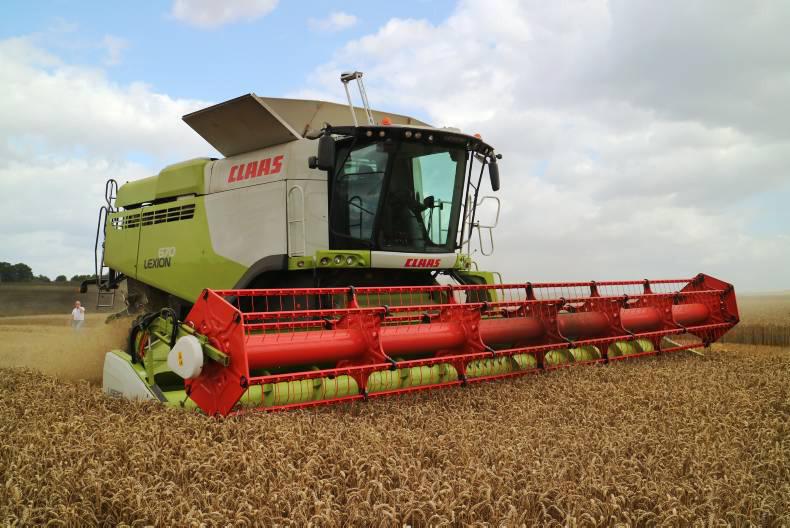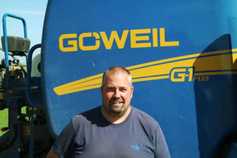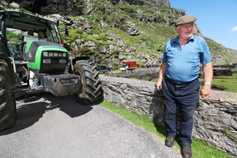
LOYALTY CODE:
The paper code cannot be redeemed when browsing in private/incognito mode. Please go to a normal browser window and enter the code there

LOYALTY CODE:
The paper code cannot be redeemed when browsing in private/incognito mode. Please go to a normal browser window and enter the code there
This content is copyright protected!
However, if you would like to share the information in this article, you may use the headline, summary and link below:
Title: Watch: New Claas harvest machinery for 2017
At a recent event in the UK, Claas showcased their latest developments to the Lexion and Quadrant harvest equipment for 2017.
https://www.farmersjournal.ie/watch-new-claas-harvest-machinery-for-2017-219949

ENTER YOUR LOYALTY CODE:
The reader loyalty code gives you full access to the site from when you enter it until the following Wednesday at 9pm. Find your unique code on the back page of Irish Country Living every week.

CODE ACCEPTED

You have full access to farmersjournal.ie on this browser until 9pm next Wednesday. Thank you for buying the paper and using the code.

CODE NOT VALID
Please try again or contact us.
For assistance, call 01 4199525
or email subs@farmersjournal.ie
Sign in

Incorrect details
Please try again or reset password
If would like to speak to a member of
our team, please call us on 01-4199525
Reset
password
Please enter your email address and we
will send you a link to reset your password

If would like to speak to a member of
our team, please call us on 01-4199525
Link sent to
your email
address
![]()
We have sent an email to your address.
Please click on the link in this email to reset
your password. If you can't find it in your inbox,
please check your spam folder. If you can't
find the email, please call us on 01-4199525.
![]()
Email address
not recognised
There is no subscription associated with this email
address. To read our subscriber-only content.
please subscribe or use the reader loyalty code.
If would like to speak to a member of
our team, please call us on 01-4199525
 This is a subscriber-only article
This is a subscriber-only article
Update Success !






Lexion 600 range
As part of Claas’s ongoing development of the Lexion 600 straw-walker combine range, the new 2017 models will benefit from cost-efficient engines, a new straw chopper and other advanced features previously only available on its bigger brother, the higher-capacity Lexion 700 Hybrid range.
The Lexion 600 range still comprises three six-walker models (the Lexion 670/660/650) with a drum width of 1,700mm and two five-walker models (Lexion 630/620) with a 1,420mm-wide drum. Montana hillside versions of the Lexion 670 and 630 are also available. New for 2017 is the Terra Trac Lexion 660TT, which now joins the already available 670TT in the range.

Engines
The traditionally used Caterpillar engines have now been replaced by German-made Mercedes-Benz units and all 2017 Lexion 600 range models will now be powered by Mercedes-Benz T4F compliant engines. On the largest Lexion 670 and 660, the engines will have a cubic capacity of 10.7 litres with power outputs of 435hp and 408hp, respectively, while the smaller Lexion 650/630/620 models will come fitted with 7.7-litre engines delivering power outputs of 354hp, 354hp and 313hp, respectively.
To provide adequate cooling for the new 10.7-litre engines on the Lexion 670/660, these models will feature the unique Claas Dynamic Cooling system originally developed for the Lexion 700 range.
Dynamic Cooling incorporates a hydraulically driven variable fan that automatically adjusts the cooling capacity as required by the engine, which Claas claims helps to save up to 20hp and therefore reduce fuel consumption. Located horizontally behind the engine, the radiator draws in clean air from above the combine through a 1.6m-wide rotating sieve filter. The air is then directed downwards through the radiator and engine bay, before exiting through louvers that direct the air down the side of the combine, creating a curtain of air that prevents dust rising. As a result, the engine bay is kept far cleaner and maintenance time is reduced.
Combine output is often restricted by an operator’s natural fear of pushing the combine too hard, resulting in a time-consuming blockage. To avoid this, the Claas auto crop flow control system, which was developed for the Lexion 700 range last year, is now available on all Lexion 600 models. This system works by using sensors that monitor the engine speed, the APS drum, the impellor drum and the straw chopper. The result is that the crop flow control system automatically reacts and alerts the operator to a potential blockage. This allows the operator to confidently push the combine to its maximum capacity.
Another new feature is Auto Slope control, which ensures the cleanest possible sample and minimal losses on uneven terrain. Auto Slope automatically controls the fan speed and continually adjusts this relative to the angle of the combine. When working uphill, the fan speed will be automatically reduced to avoid losses and then increased again as it goes downhill to ensure that the grain is cleaned sufficiently.
Cleaning system
Taking this a stage further, the Lexion 600 is also now available with Cemos Automatic Cleaning as an option, which was previously only available on the Lexion 700. Cemos Automatic Cleaning fully automates the grain cleaning system to ensure the cleanest possible sample. Sensors throughout the combine automatically monitor and continuously react to changing harvesting conditions far more regularly and accurately than would be possible by the operator.
In addition to continuously adjusting the fan speed, the system fully automatically controls the opening of both the upper and lower sieves to ensure that grain is cleaned to a far higher level than would be humanly possible. Depending on what they require, the operator has the choice of four operating parameters: maximum throughput; minimal fuel consumption/straw quality; high grain quality or an optimum balance of all of these.
To reduce the time spent emptying, the offloading time has been increased on Lexion 670/660 to 130 litres/second and 110 litres/second on the Lexion 670 Montana and Lexion 650-620.
For 2017, Claas has developed three new Quadrant baler models – the Quadrant 5300, 5200 and 4200. At the core of these new models has been the redevelopment of Claas’s oldest patented product – the knotter.

The first Claas knotter was patented in 1921 and with over one million units now having been produced, Claas is still the only baler manufacturer to design and manufacture its own knotters.
Automatic pressure control (APC)
In addition to the new knotters, the new Quadrant baler also features heavier duty drive systems, longer bale chambers and the new patented Claas APC system. Standard on the Quadrant 5300/5200 and optional on the Quadrant 4200, APC ensures that bale weight is maintained by automatically monitoring the knotters and the stress on the drive system.
Having entered both the required bale density and the quality of the baling string being used into the ISOBUS terminal, by monitoring sensors recording the deflection of the main beam and knotter tension on three of the knotters, APC will automatically maintain the target chamber pressure. This ensures that a uniform bale weight is maintained regardless of variations in crop quality.
As an option on the Quadrant 4200 and standard on the Quadrant 5300/5200, the knotter control system (KCS) is also available where sensors are fitted to all six knotters. With the KCS, stress on each of the knotters is monitored to detect any broken strings or a missed knot. This will then result in an alarm on the control terminal to alert the driver.
Producing a bale measuring 70cm x 120cm, the new Quadrant 5200 and 4200 replace the current Quadrant 3200 and 2200 models. The larger Quadrant 5300 produces a bale measuring 90cm x 120cm and replaces the Quadrant 3300.
Hydraulic drive option
At the front, all three new models have a hydraulically suspended 2.35m-wide pickup, fitted with a double roller crop press and power feeding system (PFS) auger as standard.

By being able to vary the pickup speed from between 200rpm and 260rpm, hydraulic drive allows the operator to match the speed of the pickup to the crop, using a higher speed for small swaths, for example, or reducing the speed to minimise damage in crops such as Lucerne or hay.
The hydraulic drive also allows the PFS and crop press to be reversed in the event of a blockage.
All three models feature a pre-chamber ahead of the main chamber.
On the Quadrant 4200, the packing tines operate on a three-phase cycle, driven by an oil-immersed gearbox and clutch drive system with automatic overload protection.
On the Quadrant 5300/5200, there is electro-hydraulic control of the packing tines to provide optimum bale density and shape in varying crop conditions.
On all three Quadrants, in order to achieve greater bale density and higher overall output, the bale chamber has been further strengthened and the length increased by up to 15%.

On the Quadrant 5200 and 4200, the chamber is fitted with three pressure rams, while there are six on the Quadrant 5300.
On the Quadrant 5200, ram frequency has been increased to 56 strokes/minute and on all models the ram, connecting rods and bearings have been strengthened.
New knotter system
The knotter system fitted to all three models features a new bill hook, string guide finger, string clamping plate and disc design, which creates a single, improved shape of knot with longer ends for greater hold in all baling conditions with no string waste.
To ensure that the knotters stay clean, the new Quadrants are fitted with a hydraulically-powered turbo fan system, similar to that used for the Lexion Jet Stream system.

New active oscillating diffusers direct the air, which travels at 140m/h, over both the front and the sides of each knotter, ensuring that they are kept clean at all times.
For ease of maintenance, instead of being bolted down, each knotter assembly can now be swivelled upwards and for working at night, both the string box and needles can be fitted with LED lighting.




SHARING OPTIONS: